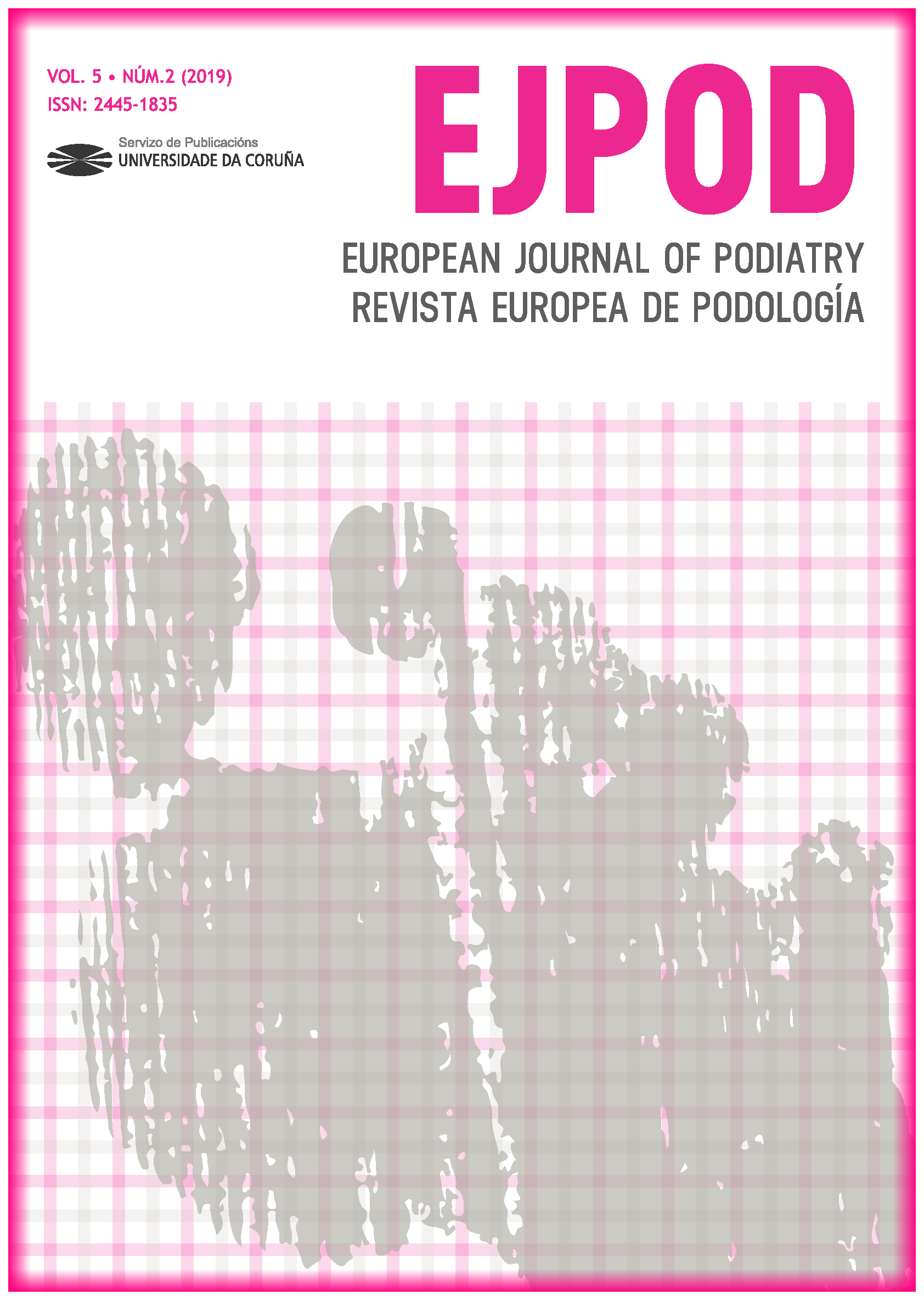Tratamiento quirúrgico del pie plano adquirido del adulto. Caso clínico
Contenido principal del artículo
DOI:
https://doi.org/10.17979/ejpod.2019.5.2.3446Resumen
El presente estudio describe un caso de una paciente de 55 años que presenta dolor e inflamación de un año de evolución en la zona interna del tobillo y dificultad para caminar y ponerse de puntillas.
Tras realizar una exhaustiva valoración clínica y pruebas de imagen, se diagnostica a la paciente de pie plano adquirido del adulto con disfunción del tibial posterior, desgarro longitudinal del tendón tibial posterior y hallux abductus valgus bilateral.
A continuación, se describe el procedimiento quirúrgico realizado, que consiste en 4 principales abordajes: reparación del tendón tibial posterior, fusión subastragalina, fusión cuneometatarsal de primer radio mediante la técnica de Lapidus y exostectomía del búnion de la cabeza del primer metatarsiano.
En la evaluación postoperatoria se observó una disminución de la sintomatología dolorosa, así como una mejoría funcional considerable.
Un mayor conocimiento de este tipo de técnicas quirúrgicas y de sus ventajas e inconvenientes permitiría que ante situaciones de fracaso del tratamiento conservador, un mayor número de pacientes puedan lograr un aumento en su calidad de vida. Es necesario un seguimiento a largo plazo de este tipo de casos, así como un estudio pormenorizado de las técnicas quirúrgicas que permitan un mayor abanico terapéutico para el tratamiento de este tipo de patologías.
Palabras clave:
Detalles del artículo
Referencias
Albano D, Martinelli N, Bianchi A, Romeo G, Bulfamante G, Galia M, et al. Posterior tibial tendon dysfunction: Clinical and magnetic resonance imaging findings having histology as reference standard. Eur J Radiol. 2018;99(October 2017):55–61.
Ceccarini P, Rinonapoli G, Gambaracci G, Bisaccia M, Ceccarini A, Caraffa A. The arthroereisis procedure in adult flexible flatfoot grade IIA due to insufficiency of posterior tibial tendon. Foot Ankle Surg. 2016;(September):7731.
Crevoisier X, Assal M, Stanekova K. Hallux valgus, ankle osteoarthrosis and adult acquired flatfoot deformity: a review of three common foot and ankle pathologies and their treatments. EFORT Open Rev [Internet]. 2016;1(3):58–64. Available from: http://www.efortopenreviews.org/lookup/doi/10.1302/2058-5241.1.000015
Johnson KA, Strom DE. Tibialis posterior tendon dysfunction. Clin Orthop Relat Res. 1989;(239):196–206.
Kohls-Gatzoulis J, Angel JC, Singh D, Haddad F, Livingstone J, Berry G. Tibialis posterior dysfunction: a common and treatable cause of adult acquired flatfoot. Bmj. 2004;329(7478):1328–33.
Kunas GC, Probasco W, Haleem AM, Burket JC, Williamson ERC, Ellis SJ. Evaluation of peritalar subluxation in adult acquired flatfoot deformity using computed tomography and weightbearing multiplanar imaging. Foot Ankle Surg [Internet]. 2016; Available from: http://dx.doi.org/10.1016/j.fas.2017.05.010
Mann RA, Beaman DN HG. Isolated subtalar arthrodesis. Foot Ankle Int. 1998;19:511–9.
MS. M. Adult acquired flatfoot deformity. J Bone Jt Surg Am. 1996;78:780–92.
Pinney SJ, Lin SS. Current concept review: Acquired adult flatfoot deformity. Foot Ankle Int. 2006;27(1):66–75.
Taylor R SJ. Minimizing the role of fusion in the rigid flatfoot. Foot Ankle Clin. 2012;17:337–49.
Wadehra A, Fallat LM, Jarski R. Surgical Management of Stage 2 Adult and Pediatric Acquired Flatfoot Without Tendon Transfer or Arthrodesis: A Retrospective Study. J Foot Ankle Surg [Internet]. 2018; Available from: http://linkinghub.elsevier.com/retrieve/pii/S1067251617306877
Walters JL, Mendicino SS. The flexible adult flatfoot. Anatomy and pathomechanics. Clin Podiatr Med Surg [Internet]. 2014;31(3):329–36. Available from: http://dx.doi.org/10.1016/j.cpm.2014.03.005


